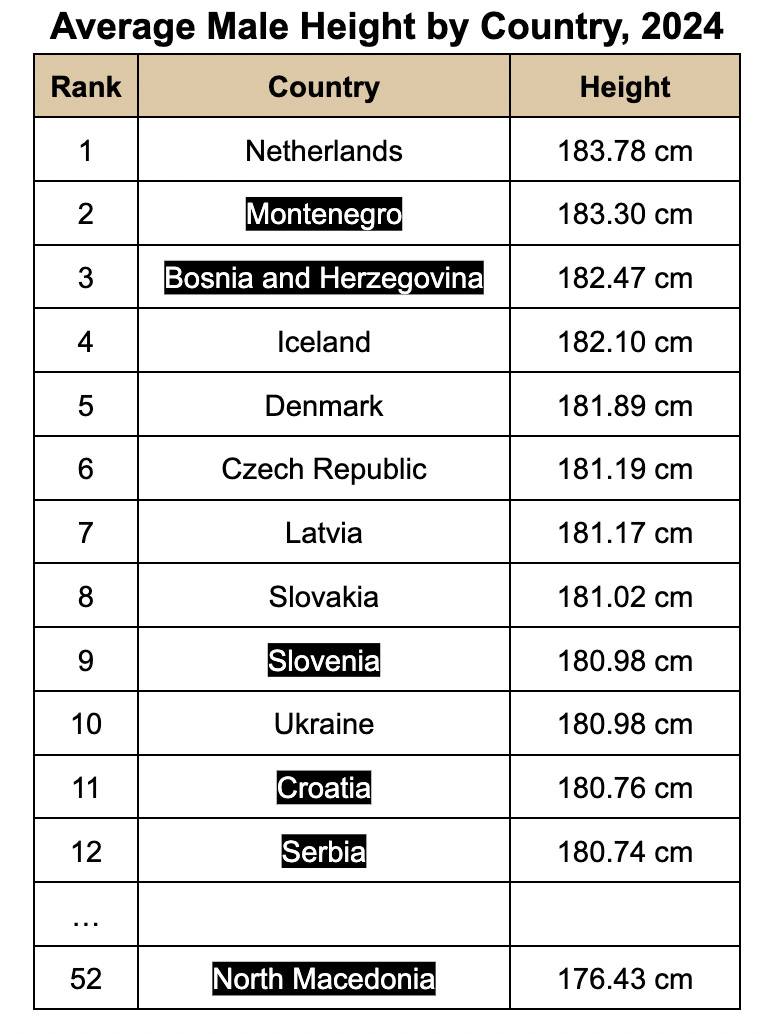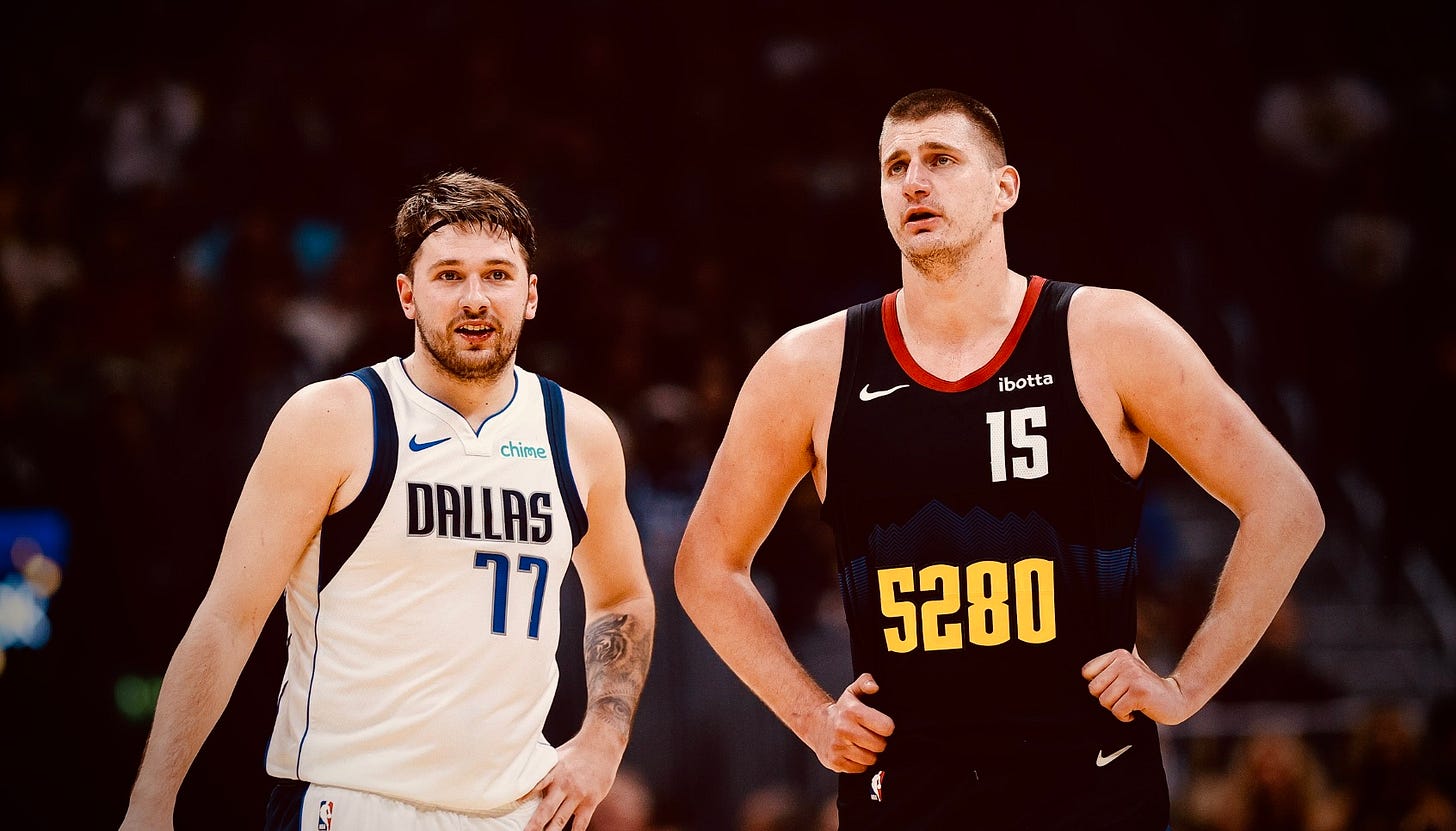The Lost Basketball Empire
The what-if pairing of Jokić and Dončić
When you think of countries that dominate basketball you think of the United States. In the next tier, you probably think of Spain, France, Canada, and Australia. However, there is one region of the world that is often overlooked because it is no longer a single country.
Nikola Jokić. Novak Djokovic. Dražen Petrović. Luka Modrić. Vlade Divac. Nemanja Vidić. Luka Dončić. What do all these well-known and successful athletes have in common? They all come from countries within the former Yugoslavia.
Yugoslavia’s Fingerprints on Today’s Game
If we look strictly at the All-NBA First Team this last year, we have one American (Jayson Tatum), one Canadian (Shai Gilgeous-Alexander), and three players from southeastern Europe (Giannis Antetokounmpo, Nikola Jokić, and Luka Dončić). Of the three from Europe, two (Nikola Jokić and Luka Dončić) are from the former Yugoslavia (Serbia and Slovenia).
The Yugoslav region is now made up of six countries—seven if you count Kosovo, which is partially recognized as an independent country. These countries (Bosnia and Herzegovina, Croatia, Kosovo, Montenegro, North Macedonia, Serbia, and Slovenia) have about 24 million residents, which would make it the ninth largest European nation, just behind Poland and just ahead of Romania. To put that in perspective, 24 million people is slightly larger than the state of Florida.
According to Basketball Reference, there are currently 18 players from countries in the former Yugoslav region in today’s NBA. The number of current NBA players from Florida? Just 17.
In fact, the former Yugoslavian nations have more players in the NBA than France (13), Australia (13), Germany (8), Spain (2), Lithuania (3), and Italy (4). Outside of Canada (26), the former Yugoslavia would represent the most foreign-born NBA players.
The EuroLeague, the equivalent to the Champions League in soccer, has the best basketball teams in Europe compete. Of the 296 players competing in the EuroLeague last year, the United States had the most athletes with 84. Second, however, was Serbia with 25. If you add up all the players from the former Yugoslavian countries, that would put the total at 35—still far below the United States, but firmly ahead of the third most athletes from a single country in 21 (Germany and France).
As you can tell from the many names of successful athletes from the beginning of this article, countries now in the former Yugoslav region are excelling in sports other than basketball. If you look at the number of soccer players playing in foreign leagues worldwide, you will see that all six Yugoslav countries are among the top eight soccer exporters per one million residents.
The Rise and Fall of Yugoslavian Basketball
To understand how the former Yugoslavia became such a sporting power, you need to first understand a bit about its history.
Yugoslavia was formed right after World War I to protect themselves from invasions—strength in numbers, if you will. Still, during World War II, Germany invaded and occupied Yugoslavia. A commander by the name of Josip Broz Tito led a resistance movement that eventually liberated the country and reunified Yugoslavia. Under his communist reign, Tito needed to find a way to create unity among so many different ethnic groups in a fragile Yugoslavia. His answer: Sports.
With investment in infrastructure and homegrown leagues, sports became a passionate rallying cry for Yugoslavians. Though soccer was the nation’s most popular sport, Yugoslavia became a breeding ground for basketball stars.
Basketball seemed to be a natural fit. The region produces some of the tallest people in the world. Basketball and Yugoslavia was a match made in heaven.

One reason the Yugoslav region is so talented is because of the concept of positionless basketball. Players are often taught from a young age how to dribble the ball and learn the fundamentals of the game, no matter how tall the athlete is. Many centers are taught how to handle the ball like a point guard. Just watch Jokić and Dončić and you will see how positionless basketball has made them into the offensive threats they are today.
Yugoslavia’s basketball team started to compete for European and World championships in the 1960s. By the 1970s, Yugoslavia was a consistent title contender on the world stage. They won the FIBA World Cup in 1970 and 1978 and took home three European Championships in 1973, 1975, and 1977.
Interestingly, Yugoslavia’s robust leagues prevented its sports stars from playing outside the country during this time. None of the players on the 1970s championship teams ever stepped foot on an NBA court. But that all changed in the 1980s. Players such as Dražen Petrović, Toni Kukoč, and Vlade Divac led a new generation of Yugoslavian players.
The new core of teenagers won tournaments all over the world. In 1987 they went to the U19 World Championships and dominated throughout, including beating a young Larry Johnson and Gary Payton-led United States team twice. They then beat the United States again in the semifinals of the 1990 FIBA World Cup while on their way to winning the tournament.
This young core of Yugoslavian players looked to be on their way to winning a gold medal at the 1992 Olympics. That’s when the United States decided to send their best players to the Olympics and international tournaments.
Simultaneously, tensions at home were simmering. After the death of Tito in 1980, no leader was able to reign in the growing animosity among ethnic groups. By the early 1990s civil war had erupted. Slovenia and Croatia first declared independence in 1991 and then the others followed. In total, the wars lasted 10 years. Players who were once teammates now had different national flags. ESPN’s 30 for 30, Once Brothers, gives a great depiction of what the situation was like.
Croatia competed at the 1992 Olympics but didn’t have a full Yugoslavian team to compete as they did just a few years earlier. They made the gold medal game but lost to the Dream Team by 32 points.
The Next Generation
Players from the region today like to credit their collective basketball success to what is called, inat. The Ringer wrote about the word and said it was heard everywhere when traveling in the former Yugoslav region.
In that same piece for The Ringer, Bogdan Bogdanović said, “It means you can’t break us. Whatever you do, whatever you try, I’ll try harder. It starts with our history. How we kept our culture over the years.”
Jusuf Nurkić, a Bosnian Muslim, recalled how the largest massacre in Europe since World War II killed 8,000 Bosnian Muslims during the wars in 1995. He spoke about the matter with The Ringer saying:
“We still survived and saved the country. That’s the qualification of inat. You only have what you got, man. That’s your home. If you don’t want to fight for that, you’re done.”
After the wars, the newly formed countries in the region started to pick up the pieces and a resemblance of its basketball powers started to return. There were a few players here and there that made it to the NBA—Peja Stojaković and Darko Miličić, for example. But the wars took its toll on the region’s pipeline to the NBA.
Coaches started to return to the region and propped up the next generation of youth, which is the byproduct of what we see in today’s NBA.
Nikola Jokić. Luka Dončić. Nikola Vučević. Bogdan Bogdanović. Nikola Jović. Boban Marjanović. Ivica Zubac. Jusuf Nurkić. Goran Dragić. Dario Šarić. Bojan Bogdanović. All these players come from countries within former Yugoslavia.
If Yugoslavia were still a country today, one could argue it would be a perennial power with the United States. We just saw the United States barely outlast Serbia in the Olympic semifinals. Just imagine adding a pool of players from five additional countries to Serbia’s team. A lineup featuring Vučević, Jokić, Bogdanović, and Dončić would be a force offensively.
One of the best parts about this generation’s players from the region is that they all get along despite the recent Yugoslav Wars. The Athletic did a story on the 2020 bubble at Disney World when players from across the region would get together at one of the restaurants to sing, laugh, and bond.
Yugoslavian basketball is a story of what-ifs. We’ll continue to see players thrive coming out of the Yugoslav region, but we’ll never know how good they could have been at the highest levels of international basketball.






